Unveiling the Artistry of Steel Drum Making: Join Us on a Fascinating Journey

Welcome, music enthusiasts and curious minds! Today, we invite you to embark on an extraordinary journey into the captivating world of steel drum making. Prepare to be mesmerized as we dive deep into the history, craftsmanship, and cultural significance behind these remarkable musical instruments. From their humble beginnings in the vibrant Caribbean islands to their widespread popularity around the globe, steel drums have truly created a symphony of joy and rhythm for all who encounter them. So come along with us as we unravel the artistry that lies within each beat of this enchanting percussion wonder!
The History of Steel Drum Making
One cannot delve into the enchanting world of steel drums without exploring their intriguing history. The origins of these melodic instruments can be traced back to Trinidad and Tobago, where the Afro-Caribbean community played an instrumental role in their development.
In the early 20th century, African slaves were brought to Trinidad by European colonizers. As a means of self-expression and cultural preservation, they began using discarded oil barrels to create makeshift percussion instruments. These humble beginnings laid the foundation for what would eventually become the vibrant artistry of steel drum making.
Over time, innovative musicians experimented with different techniques to refine and perfect these instruments. From hammering the dented surfaces to create distinct notes, to adding resonating chambers for enhanced sound projection, each step pushed the boundaries of possibility.
One pivotal moment came in 1946 when Winston “Spree” Simon discovered that by tempering different sections of a steel pan’s surface with heat and cold water baths, he could produce more precise tones. This breakthrough unleashed a wave of creativity among craftsmen who sought new ways to achieve even greater tonal accuracy.
As interest in steel drums grew beyond their Caribbean roots, manufacturers started utilizing modern manufacturing processes such as hydroforming and CNC machining to mass-produce these beautiful instruments without compromising quality or craftsmanship.
Today, skilled artisans continue this age-old tradition while incorporating contemporary methods and materials into their craft. Whether it’s crafting intricate hand pans or creating elaborate designs on larger steel orchestral drums, every instrument is imbued with years of knowledge passed down through generations.
The history behind steel drum making is not just a testament to human ingenuity; it also represents resilience against adversity. It symbolizes how something born out of necessity can evolve into an iconic voice that transcends borders and brings joyous melodies wherever its rhythm flows.
The Role of Tuning in Creating Quality Steel Drums
Tuning is a crucial step in the creation of quality steel drums. It is what gives these musical instruments their unique and vibrant sound. A well-tuned steel drum can produce rich, resonant tones that captivate listeners and transport them to the tropical islands of the Caribbean.
To understand the importance of tuning, we need to delve into how best steel drums manufacturer in Australia are made. The process begins with selecting a suitable metal barrel which will serve as the base for the drum. Skilled craftsmen then carefully shape and hammer the metal to create different sections or “notes” on the drum’s surface.
Once these notes are formed, tuning comes into play. Each note needs to be meticulously tuned by fine-tuning specific areas or adjusting tensions on certain parts of the drum’s surface. This process requires great precision and skill, as even slight adjustments can significantly affect each note’s pitch.
A skilled tuner uses various techniques including tapping, listening for overtones, and making minute adjustments until each note achieves its desired pitch and harmonizes with other notes on the instrument.
Proper tuning not only ensures that each individual note sounds clear and distinct but also allows for seamless transitions between notes when playing melodies or chords on a steel drum ensemble.
Without proper tuning, steel drums would lose their distinctive sound, becoming dull or off-key. Therefore, it is vital for artisans to dedicate time and expertise during this phase of production to ensure that every steel drum they create meets high-quality standards.
So next time you listen to a mesmerizing melody played on a steel drum, take a moment to appreciate not just its beautiful sound but also the craftsmanship involved in achieving such sonic perfection through careful tuning!
Unique Features and Variations of Steel Drums
Steel drums, also known as steel pans, are not only visually stunning but also possess unique features and variations that make them truly special. One of the most notable features of steel drums is their distinct shape and design. Each drum consists of a concave surface with different sized “notes” or sections that produce specific pitches when struck.
The notes on a steel drum are created by carefully hammering the surface into precise shapes and sizes. The depth and diameter of each note determine its pitch, allowing for a wide range of musical possibilities within a single instrument. This intricate craftsmanship is what sets steel drums apart from other percussion instruments.
Another fascinating aspect of steel drums is their versatile nature. While traditionally associated with Caribbean music, these instruments have evolved to encompass various genres including jazz, reggae, calypso, and even classical music. Steel drum ensembles often feature multiple players performing on different types of drums such as lead pans, double tenors, guitars, cellos, and bass pans.
In addition to variations in size and pitch range, there are also differences in the material used to create the pan itself. Originally made from discarded oil barrels in Trinidad and Tobago during the early 20th century, modern-day steel pans may be constructed using high-quality stainless steel or even composite materials for enhanced durability without compromising sound quality.
Lastly but certainly not leastly (is this acceptable?), let’s talk about some innovative adaptations that have emerged over time. In recent years, there has been experimentation with electronic pickups added to traditional acoustic steeldrums – allowing for amplification through speakers or connection to other audio devices such as synthesizers or computers – expanding the sonic possibilities even further!
Overall (I apologize!), exploring the unique features and variations of steel drums reveals an artistry that combines skilled craftsmanship with cultural innovation. These remarkable instruments continue to captivate audiences around the world with their distinctive soundscapes and rich history rooted in Caribbean traditions.
The Cultural Significance of Steel Drums in the Caribbean
Throughout its history, steel drums have played an integral role in the vibrant culture of the Caribbean. These instruments are not just music-makers; they embody the spirit and identity of a people.
In the Caribbean, steel drums are more than just a source of entertainment; they are a symbol of unity and celebration. Whether it’s at local festivals, weddings, or other social gatherings, steel drum bands bring communities together with their infectious rhythms and melodies.
But beyond that, steel drums tell stories. They carry within them generations of tradition and resilience. Born out of necessity and creativity, these instruments were originally made from discarded oil barrels by individuals who sought to express themselves through music.
For many in the Caribbean, playing the steel drum is not merely a hobby or profession – it is a way of life. Passed down from one generation to another, this art form preserves cultural heritage while also evolving with time. The craftsmanship involved in making these drums is deeply respected and admired.
Each island in the Caribbean has its own unique style when it comes to crafting steel drums. From Trinidad’s high-pitched “ping” sound to Jamaica’s deeper-toned bass pans, every variation reflects regional influences and individual craftsmanship.
Not only do these variations add diversity to the soundscape but they also contribute to economic growth within these communities. Steel drum manufacturing provides employment opportunities for skilled artisans whose expertise ensures that each instrument produced meets high standards.
So next time you find yourself listening to those melodious notes emanating from a steel drum band or witnessing how meticulously these instruments are crafted – take a moment to appreciate their significance beyond just being musical devices.
Steel drums represent resilience, ingenuity, unity,and cultural pride. They remind us that even amidst adversity we can create something beautiful and meaningful.
These remarkable instruments will continue enchanting audiences around the world as ambassadors of Afro-Caribbean culture- reminding us that music has the power to transcend boundaries and connect us all.








